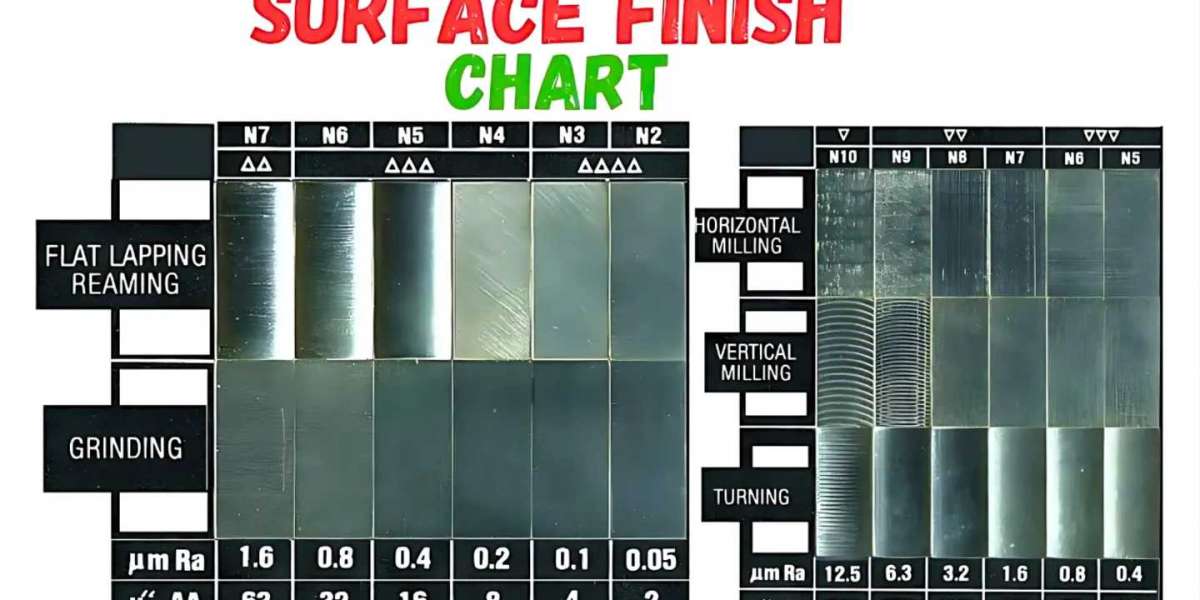In the world of manufacturing, one of the most critical factors determining the quality of a product is its surface finish. This term refers to the texture or smoothness of a part's surface after a machining process. Achieving the correct surface finish is essential for ensuring that a component performs well, looks appealing, and meets stringent safety standards. To aid in this process, manufacturers often refer to a machining surface finish chart—a tool that provides a visual guide for understanding and selecting appropriate machining processes to achieve desired surface qualities. In this article, we will explore what a machining surface finish chart is, why it’s important, and how to use it effectively in your machining operations.
What is a Machining Surface Finish Chart?
A machining surface finish chart is a reference tool used by machinists and engineers to select and compare the surface roughness achievable by different machining processes. This chart is essential for aligning the type of process used with the desired surface finish requirements, ensuring that parts meet the specific performance and aesthetic standards needed for their applications.
Understanding Surface Roughness Parameters
To interpret a surface finish chart effectively, it’s crucial to understand the common parameters used to measure surface roughness:
- Ra (Arithmetic Average Roughness): This is the most commonly used parameter. It represents the average of the absolute values of the surface height deviations measured from the mean line over a specified length. Ra values are measured in micrometers (µm) or microinches (μin) and indicate the overall smoothness of a surface.
- Rz (Average Maximum Height of the Profile): Rz measures the average distance between the highest peak and the lowest valley within a specific sampling length. It is useful for assessing more significant peaks and valleys in the surface profile.
- Rq (Root Mean Square Roughness): Rq is similar to Ra but is calculated using the square root of the mean of the squares of the deviations. This parameter provides more weight to larger deviations, which can be helpful when evaluating parts with significant roughness variations.
- Rt (Total Height of the Profile): Rt is the total height between the highest peak and the deepest valley over the measured length. It’s used to understand the extreme deviations present in the surface profile.
These parameters help define the texture of the part’s surface and are crucial for choosing the right machining method to achieve the desired finish.
Why Is a Machining Surface Finish Chart Important?
A surface finish chart is important for several reasons:
1. Ensures High-Quality Output
A machining surface finish chart helps manufacturers achieve a consistent and high-quality finish that meets product specifications. This is particularly important in industries where precision and smooth surfaces are critical, such as aerospace, automotive, and medical device manufacturing.
2. Optimizes Manufacturing Processes
Choosing the right machining process can save time and resources. By using a surface finish chart, manufacturers can identify which processes are most suitable for achieving a desired roughness, avoiding unnecessary steps and excessive tool wear.
3. Improves Part Performance and Durability
Surface roughness can directly impact the functionality and longevity of parts. For example, smoother surfaces can reduce friction in moving parts, leading to better performance and less wear. This is vital for mechanical parts in engines, gears, or other assemblies where smooth operation is essential.
4. Enhances Safety
In industries where safety is paramount, such as the aerospace and medical industries, surface finish can play a critical role. A smooth surface helps prevent stress concentration points that could lead to fractures or other failures, ensuring the component can withstand operational loads.
5. Aesthetic Appeal
In consumer-facing products, the visual appeal of a part can affect customer perception and sales. Achieving a fine surface finish can make a product look more polished and high-quality, making it more attractive to consumers.
How to Read a Machining Surface Finish Chart
To use a machining surface finish chart, it’s important to understand how to interpret the data provided. The chart will typically display different machining methods and their corresponding Ra values. Here’s how to read and apply the information:
1. Identify the Desired Surface Finish
Start by determining the required surface finish for your specific application. This requirement can be found in the design specifications or industry standards for the type of part being produced.
2. Locate the Desired Roughness Value
Find the Ra or other roughness values on the chart. This will indicate which machining processes can achieve the desired level of smoothness.
3. Select the Appropriate Machining Process
Once you’ve identified the desired Ra value, look at the chart to see which machining processes can achieve this. Common processes include:
- Turning: Produces an average surface finish in the range of 1.6–6.3 µm Ra. It is suitable for parts that do not require ultra-fine finishes but need good mechanical properties.
- Milling: Achieves surface finishes between 0.8–3.2 µm Ra, making it ideal for medium-level finish requirements.
- Grinding: Known for achieving finer surface finishes, typically in the range of 0.2–0.8 µm Ra. It is used for high-precision parts.
- Polishing and Lapping: Used for ultra-smooth finishes with Ra values as low as 0.1 µm or even finer. These processes are essential for parts requiring mirror-like surfaces.
4. Adjust Machine Settings
Ensure that the chosen machining process is optimized for the desired finish. This may involve adjusting parameters like spindle speed, feed rate, depth of cut, and the condition of the tooling. Using the right cutting fluids can also improve the surface finish and extend tool life.
Common Machining Processes and Their Surface Finishes
1. Turning
Turning uses a single-point cutting tool to remove material from a rotating workpiece. The surface finish achieved depends on tool sharpness, cutting speed, and feed rate. For general turning, Ra values range from 1.6 to 6.3 µm, but by refining the cutting conditions and using fine cutting tools, finishes below 1 µm can be achieved.
2. Milling
Milling involves rotating multiple cutting tools to remove material. It can produce surface finishes between 0.8 and 3.2 µm Ra, depending on the tool type and machining parameters. Higher cutting speeds and fine tooling can produce smoother surfaces.
3. Grinding
Grinding utilizes an abrasive wheel to achieve a finer finish. It can produce finishes from 0.2 to 0.8 µm Ra, making it suitable for high-precision parts. The key to grinding is selecting the correct abrasive type, wheel speed, and pressure applied.
4. Polishing and Lapping
These finishing processes are used to achieve extremely fine surface finishes with Ra values below 0.1 µm. Polishing uses a rotating cloth with an abrasive compound to smooth the surface, while lapping involves a rotating plate with an abrasive slurry. Both methods are ideal for optical components, precision instruments, and other high-spec applications.
Tips for Using a Machining Surface Finish Chart
- Understand the Application: Different parts have different requirements. For high-performance components, it’s worth investing in processes that achieve finer finishes.
- Account for Material Type: Harder materials may need more time or specialized tools to achieve a fine finish, while softer materials may be easier to machine.
- Monitor Tool Condition: Dull tools can lead to a rougher finish and faster wear. Regularly inspect and replace cutting tools as needed.
- Optimize Cutting Parameters: Adjust feed rates, cutting speeds, and depth of cut to get the best possible finish for the process being used.
- Use the Right Lubrication: Cutting fluids and lubricants can help achieve a smoother finish by reducing heat and friction during machining.
Conclusion
A machining surface finish chart is a powerful tool for any manufacturer or machinist looking to optimize their production processes. By understanding how to read and use the chart, you can select the right machining methods to achieve the desired surface roughness for your parts. This not only ensures high-quality output but also improves performance, safety, and durability while enhancing the overall visual appeal of the product. Whether working on industrial machinery, consumer products, or high-precision components, mastering the use of a surface finish chart is key to producing exceptional results.



